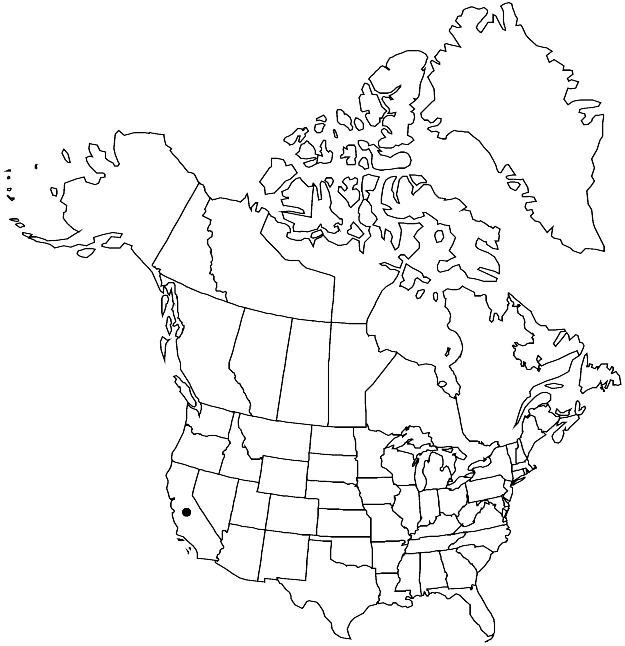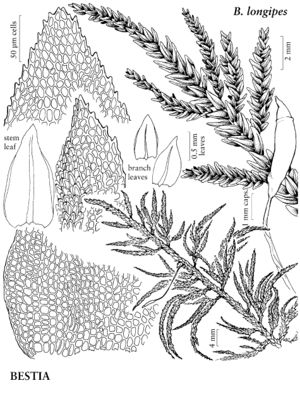Bestia longipes
in H. G. A. Engler and K. Prantl, Nat. Pflanzenfam. 226[I,3]: 859. 1906.
Plants in pendulous wefts, green to deep green. Stems to 12 cm, secondary branches to 1 cm, usually curved to one side when dry; rhizoids rare, inserted on stem base, pale brown, unbranched, smooth; axillary hairs 4–5 µm wide at insertion, 10 µm wide distally, basal cells 2, brown, apical cell 40 µm, hyaline; pseudoparaphyllia as broad as long, margins serrate at base, cells short. Leaves imbricate when dry, erect-spreading when moist, straight, symmetric, somewhat concave at base, to 1.6 mm, 3–5:1; margins narrowly recurved at least at mid leaf; apex broadly acute; costa to within 10 cells of apex, stout, abaxial surface with many spines distally; alar cells quadrate, walls thick, lumina rounded, region extending more than 20 cells up margins and inward to basal plica, auriculate at small decurrency; laminal cells short, walls thick; medial cells 5–6 µm wide, 1.2–1.8:1, smooth, lumen to wall ratio 2–4:1, walls not or inconspicuously porose; distal cells prorulate at distal ends; basal juxtacostal cells somewhat more elongate, 3–4:1; apical cells similar to medial cells, often prorate-spinose in small patch near costal apex. Specialized asexual reproduction absent. Perigonia ventral on main axes, on short stalk, spheric, budlike, bracts broadly ovate, 1.2–1.4:1, sparsely cloaking. Perichaetia ventral on main erect axes, leaves 2–3 mm, ecostate or costa short, strongly convolute around seta, inner leaves with post-fertilization development abruptly acuminate from elliptic base. Seta erect, sporophyte often shorter than adjacent lateral branches. Capsule pale brown, not distorted or sulcate when dry, urn to 4 mm, 4–5:1; operculum 1/5 urn length; exostome to 500 µm, teeth erect when dry, pale yellow, long, very narrow, base 50 µm wide, evenly contracted from base without shoulder, external surface horizontally to obliquely striate basally, smooth to lightly papillose distally; endostome smooth, basal membrane short, segments shorter than exostome, very narrow, perforate along median line, cilia paired, appendiculate. Spores 10–14 µm, smooth.
Habitat: Rock walls, boulders, along streams, coastal mountains influenced by summer fog, basal burls of broadleaf trees, especially Umbellularia californica
Elevation: low elevations
Distribution

Calif.
Discussion
Bestia longipes is usually recognized by its erect to decumbent, frondose branching. The branches have an elongate main axis with markedly shorter branch axes; there may be a 10:1 length to width ratio. Bestia longipes is infrequently collected with sporophytes, which may be difficult to see. This is due to the fact that sporophytes initiate from perichaetia inserted on the ventral side of the decumbent main axis, thereby seta elongation parallels the stem and substrate as opposed to being elevated. Additionally, the sporophytes are not much longer than the closely associated ultimate branch axes. Bestia can be confused in the field only with Isothecium, especially hydrated plants when both occur mixed. Bestia can be readily distinguished by the leaf margins that are serrate only distally, uniform laminal cells, generally 4:1, and prominent costa, extending to within 10 cells of the apex. In Isothecium, the serrations occur over a much larger portion of the margin, the alar region is distinctly lighter colored than the remainder of the lamina, and juxtacostal cells approach 8:1.
Selected References
None.
